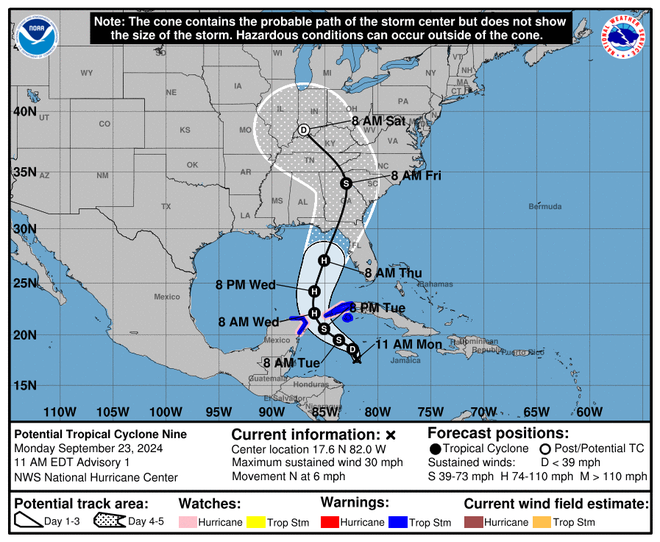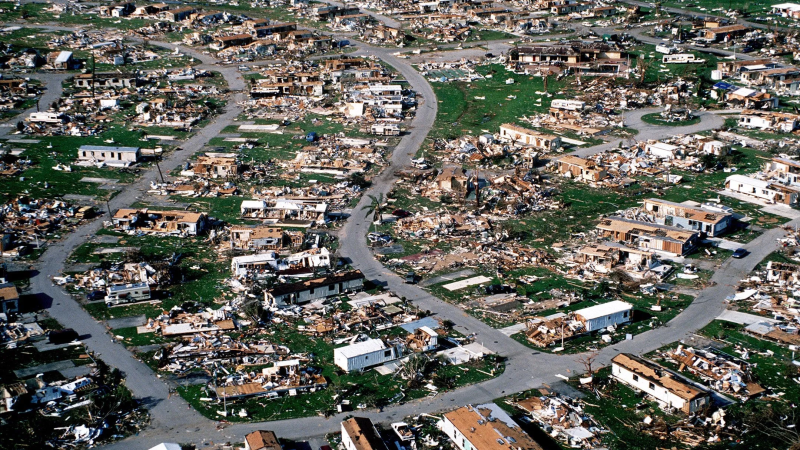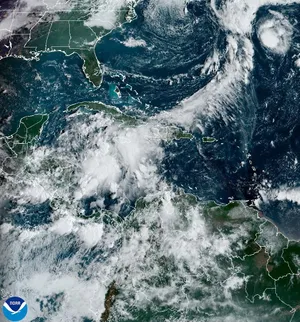'Go into hurricane mode now': Helene expected to lash Florida this week
(This story was updated to add new information.)
A brewing storm in the Caribbean Sea is forecast to strengthen into a hurricane in the Gulf of Mexico over the next few days and make landfall along the Gulf Coast as early as Thursday − possibly as a major Category 3 system.
“Everyone along the Florida Panhandle and Big Bend region needs to be prepared for hurricane impacts,” AccuWeather Lead Hurricane Expert Alex DaSilva said Monday, adding that the setup has the potential to become the strongest hurricane landfall in the U.S. so far this season.
WeatherTiger Meteorologist Ryan Truchelut put it succinctly in an online post Monday afternoon: "Helene will come at you faster than you think, so go into hurricane mode now. While there remains uncertainty in both the track and intensity forecast, Florida isn’t getting out of this one."
Florida Gov. Ron DeSantis on Monday declared a state of emergency for 41 counties along and near Florida's Gulf Coast because of threats from the storm. The declaration states there's a significant risk of storm surge and flooding, particularly in areas still recovering from the elevated water levels left behind by Hurricane Debby.
Most forecast models suggest a hurricane landfall in Florida or the northern Gulf Coast on Thursday, Weather.com meteorologist Jonathan Erdman said.
The system, elevated to "potential tropical cyclone nine" status Monday morning, will be named Helene once it becomes a tropical storm, which is expected to happen later Monday or Tuesday.
Tropical storm warnings and hurricane watches were also issued Monday for portions of western Cuba and the Yucatan Peninsula of Mexico.
Gulf Coast residents should prepare now, forecasters say
Unlike many hurricanes that track for days or weeks across the Atlantic Ocean, giving people ample warning for landfall, this one is forecast to develop and strengthen rapidly once it enters the Gulf of Mexico.
“Now is the time to start preparing for a hurricane landfall along the Gulf Coast. Don’t wait for this storm to be officially named,” AccuWeather meteorologist Jon Porter said.
He said there is the potential that this storm could further strengthen into a major hurricane, which is a Category 3 on the Saffir-Simpson Hurricane Wind Scale with maximum sustained winds of 111-129 mph.
This could be the storm that the 2024 hurricane season is remembered for, Porter said.
Track the storm:Tropical storm could form in Gulf of Mexico early this week

Where is the system now?
Showers and thunderstorms are gradually becoming better organized in association with a broad area of low pressure located over the northwestern Caribbean Sea, the National Hurricane Center said in a Monday forecast.
"Environmental conditions appear favorable for further development of this system," the center said.
"A tropical depression or storm is likely to form within the next day or two as the system moves northward across the northwestern Caribbean Sea and into the southeastern Gulf of Mexico, where additional development is expected."
The Hurricane Hunters will investigate the developing storm Monday, the center reported.
Storm could rapidly intensify into a formidable hurricane
Forecasters at the hurricane center warn that the system could intensify rapidly over the Gulf of Mexico, potentially reaching 110 mph.
The "environmental and oceanic conditions appear favorable for significant strengthening," the hurricane center said in its 11 a.m. discussion. One model shows a 95% chance of the storm's winds increasing by 75 mph or more over the next 72 hours, the center said.
Helene could become a formidable hurricane in the Gulf, according to Erdman, who said there is plenty of deep, warm water in the northwest Caribbean and parts of the Gulf of Mexico to power up the storm.
In fact, Erdman reported that Gulf of Mexico heat content is at record high levels for this time of year, according to University of Miami tropical scientist Brian McNoldy.

What are the expected impacts from Helene?
Wind: Sustained winds of at least 111 mph are possible. Powerful wind gusts of up to 120 mph are expected where the storm makes landfall on Thursday.
Rain: Widespread 8-12 inches of rain are likely, potentially leading to flooding. Rounds of rain will arrive as early as late Tuesday afternoon or early evening starting over the Keys and moving northward, according to the Florida Public Radio Emergency Network.
Power outages: Regional and localized power outages are expected across the Florida Panhandle and Big Bend region, as well as across much of Georgia, Alabama, southern Tennessee and pockets of far western South Carolina and North Carolina, AccuWeather said.
Tornadoes are also a major threat as the storm approaches later in the week.
High surf: In a marine forecast, the hurricane center warned it expects seas in the southeastern Gulf to reach 15 feet by Wednesday morning and peak at 25-30 feet on Thursday morning.
Storm surge also a serious threat
Storm surge will be a danger with the hurricane as it moves closer to the Gulf Coast. The highest chances for the deepest storm surge will be near where the storm makes landfall.
According to the hurricane center's latest analysis, the swath of coast with locations that could see a 1 in 10 chance of a storm surge greater than 9 feet stretches along the entire coast from Cape Coral north to Alligator Point. The higher the wind speeds, the higher the potential storm surge could be.

Fourth landfalling hurricane this year?
If the storm makes landfall as a hurricane, it would be the fourth landfalling hurricane in the mainland United Sates this year, joining Beryl, Debby and Francine.
Three other years since 2000 have had four hurricane landfalls: 2004, 2005 and 2020, said Phil Klotzbach, senior research scientist at Colorado State University.
Storm tracker
Spaghetti models for Caribbean system
Experts had predicted an 'extraordinary season'
Federal forecasters earlier this year predicted an "extraordinary" season: As many as 24 named storms possible.
A typical season sees 14 named storms, based on weather records that date from 1991 to 2020.
Hurricane John threatens Mexico
In the Pacific Ocean, the hurricane center reported Hurricane John continues to strengthen as it moves closer to the coast of southern Mexico. The system is forecast to approach the southern coast of Mexico during the next day or two and move inland on Tuesday or Wednesday.
The center said "damaging hurricane-force winds, a dangerous storm surge and life-threatening flash flooding are expected in portions of southern Mexico."
Hurricane names still to be used
The remaining Atlantic hurricane names for this season are:
HeleneIsaacJoyceKirkLeslieMiltonNadineOscarPattyRafaelSaraTonyValerieWilliam
Contributing: Dinah Voyles Pulver, USA TODAY; Cheryl McCloud, USA TODAY Network
Disclaimer: The copyright of this article belongs to the original author. Reposting this article is solely for the purpose of information dissemination and does not constitute any investment advice. If there is any infringement, please contact us immediately. We will make corrections or deletions as necessary. Thank you.





